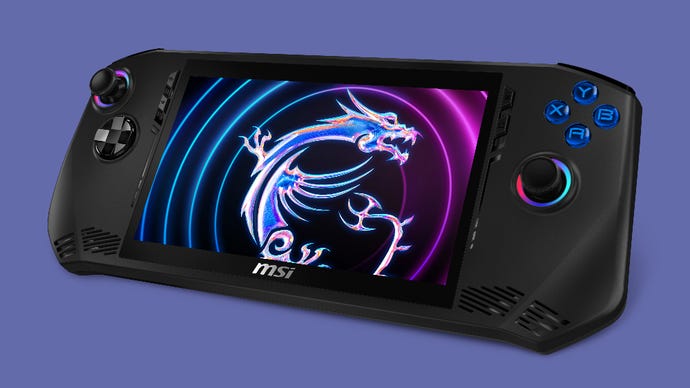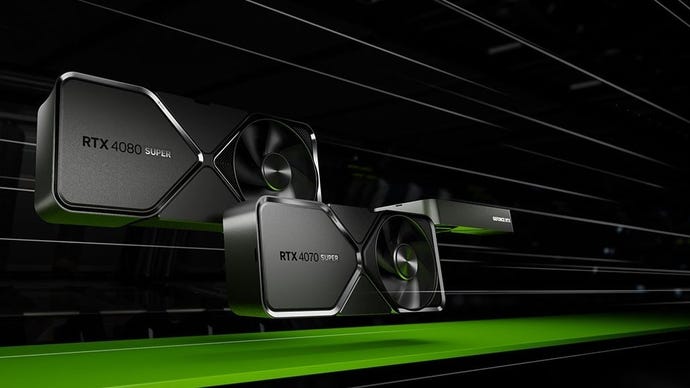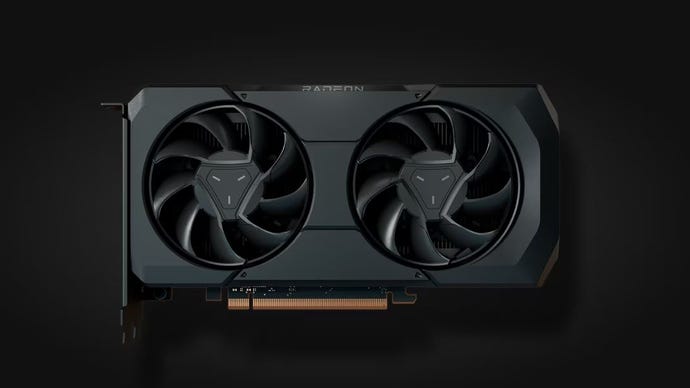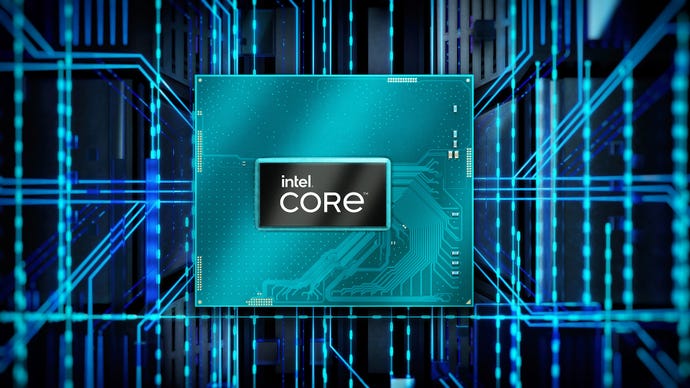CES 2024 is drawing to a close, and honestly, I’m not especially sad to see it go. While the Las Vegas tech megashow is probably the closest thing PC gaming hardware has to an E3 (and in some ways surpasses it, given CES still exists), this year’s event has been characterised by an all-too-credulous obsession with AI nonsense. Not the fun/useful DLSS kind that makes your games run faster – more the kind that replaces actual creative work with dubiously-sourced robot media. Icky stuff, even by Vegas standards.
Mercifully, not everyone was there to flog Stable Diffusion boxes and imaginary ChatGPT friends, so there is actually some interesting new kit to look forward to in 2024. I’ve rounded up the highlights here, along with some of the more questionable AI-based showings – because they may well merit discussion, even if that discussion amounts to “Is this a good idea?” followed by “No.”
The MSI Claw handheld makes an Intel power grab

Since the value of portable gaming PCs is not determined by how rad of a name it has, it remains to be seen whether the Claw can take on the Steam Deck or Lenovo Legion Go. Still, it is the first of its kind to wield one of Intel’s new, supposedly much more graphically capable Core Ultra chips, the Core Ultra 7 155H. I’m exceedingly curious to see how this fares against the AMD APUs that drive its handheld rivals, though as this was intended as a laptop CPU, power draw could be an issue – the Claw (the Clawwwww) will likely need every drop of its hefty 53Whr battery reserve.
Nvidia’s RTX 40 Super GPUs promise more power for less cash

By the end of January, there’ll be three new Nvidia GeForce graphics cards on sale: the RTX 4070 Super, RTX 4070 Ti Super, and RTX 4080 Super. All three are offering performance improvements over their non-Super originals, with starting prices that come in either equal to or below what the predecessors cost at launch. A welcome, some might say overdue change of tack, considering how bonkers expensive much of the RTX 40 lineup is.
The RTX 4070 Ti Super, in particular, is getting a complete VRAM overhaul, replacing the RTX 4070 Ti’s 8GB of memory with 16GB (and a faster bus to boot). That should make it even better for high-res play, especially with the aid of DLSS 3 – one of the few benevolent AI tools to feature at CES 2024.
AMD take another shot at the mid-range with the Radeon RX 7600 XT

While Nvidia made their Super-powered pitch to the premium market, AMD’s latest GPU launch was all about speedy 1080p. The Radeon RX 7600 XT is largely based on last year’s RX 7600, which doesn’t sound very impressive, but besides boosting clock speeds, it also rips out the latter’s 8GB of GDDR6 to replace with a more forward-thinking 16GB. That’s not going to magically make the XT model a 4K-ready beast, but it might be enough to give the rival RTX 4060 a rough time. It’ll cost more than the Nvidia card, mind, launching on January 24th from $330.
The 24th will also see Fluid Motion Frames, AMD’s attempt at a driver-based, hardware-agnostic version of DLSS 3 frame generation, emerge from its preview build into a full launch. In theory, Fluid Motion Frames should work with any DX11 or DX12 game – not just the few supported by FSR 3.
Intel’s 14th Gen CPU lineup gets bigger, more confusing

Intel’s most gaming-relevant CES announcements focused on several new handfuls of laptop and desktop CPUs, making the current 14th generation of chips an even bigger mishmash of specs and branding than it was before. Rather than adding to the previously announced, yet still very new Core Ultra series – which is comprised of multifunction APUs for slimline laptops and MSI Claws – these new-new processors use the traditional Intel branding. So there’s the 24-core core, 5.8GHz Core i9-14900HX heading up the gaming laptop chips, while the 18 new desktop CPUs range from the 24-core/32-thread Core i9-14900 all the way down to the dual-core (and likely dirt-cheap) Core Processor 300.
What I’ve tested of the 14th Gen desktop CPUs so far has been thoroughly underwhelming, characterised by practically nonexistent performance improvements over the 13th Gen equivalents. A wider range means more budget options, however, so at least there’ll be more choice for cheapo PC builds in 2024.
MSI make a gaming monitor that lets you cheat at League of Legends

I suppose dodging ganks in League of Legends isn’t the evillest application of AI imaginable, but you’d need to have quaffed an awful lot of Silicon Valley Kool-Aid to believe that the MSI MEG 321URX’s “SkySight” feature is a net good. It works by analysing enemy movements on LoL’s minimap, calculating their likely movements when they’re out of vision, and adding icons to warn you of incoming ambushes.
Look, there is maybe a use for this in some kind of offline training mode. Otherwise, it aims a shimmering, six-fingered AI punch square in the face of fair play, completely automating one of the wizard fight genre’s most fundamental skills – watching the god-damned map – and even adding new UI elements to show the exact direction of the move you’re about to artificially counter. It’s unlikely to get picked up by anti-cheat systems as well, as the AI processing is performed on the monitor rather than the PC. It’s all a bit gross, which is even more of a shame when the MEG 321URX looks like a tasty monitor otherwise: 4K resolution, 240Hz refresh rate, QD-OLED panel tech, DisplayPort 2.1. Boo.
SteamOS leaves the Valve roost with the Ayaneo Next Lite

One of the best things about the Steam Deck is SteamOS; the more I use Windows 11-based handhelds, the more I’m convinced that any game compatibility issues SteamOS has are outweighed by its convenience and general slickness. Qualities born directly from it being designed for these small, touch- and joypad-operated devices in the first place, very much unlike Windows.
That’s why the Ayaneo Next Lite intrigues me so: it’s the first post-Deck portable PC, not counting the Steam Deck OLED, to come with SteamOS preinstalled as standard. And, while pricing hasn’t been announced, it’s being pitched as relatively budget-friendly handheld, with a choice of older, off-the shelf AMD laptop chips (the Ryzen 5 4500U and Ryzen 7 4800U) instead of a custom-built gaming APU. It also matches the original Steam Deck’s screen specs, fitting a 7in, 1280×800 IPS display.
More affordable Deck alternatives sounds like a fine idea to me, and the arrival of SteamOS on third party hardware tracks with what Valve told me in 2023 about wanting to work with other handheld makers. The Ayaneo Next Lite could, therefore, be the first of many.
The HP Omen Transcend 14, a truly tiny gaming laptop

CES loves its laptops almost as much as it loves machine learning, and all the major players – Asus, Acer, MSI, HP, Alienware, Razer and so – had flipping lil’ PCs to show off. Usually featuring one of the aforementioned new Intel CPUs, naturally.
The vast, vast majority of these are updates to long-running gaming laptop series, and are thus not interesting. But I’ve definitely let my head be turned by the HP Omen Transcend 14, a more compact, internally up-to-date cousin of the Omen Transcend 16 I reviewed the other day. Just look at it – if it weren’t for the RGB keyboard, that could easily pass for a thin, light, completely non-gaming ultrabook. What a happy departure from the usual practice of building a big, plastic paving slab. With racing stripes.
Less excitingly, it will cost £1700 / $1500 just for the basic RTX 4050 version, with RTX 4060 and 4070 specs only pushing that outlay upwards. The display is a nifty 120Hz OLED number, though.
Whatever this AI Mario thing was
No, this has nothing to do with PC gaming, but it so perfectly encompasses the “Didn’t stop to think if they should” vibe of CES that I simply must include it. Even at the expense of the Razer gaming car. You may have spotted it doing the rounds on Xitter anyway: an unnervingly wooden Mario hologram, mouth and moustache staccato-flapping in a doomed attempt to sync with some AI speechbox’s approximation of an Italian accent.
What is its purpose, except to suggest that maybe we all owe Chris Pratt an apology? You’d have to ask its creators, Proto Hologram, and the booth’s organisers, the AARP, formerly the American Association of Retired Persons. The two have been collaborating on the (genuinely noble) use of holograms to treat loneliness among older people, though it turns out that Mario wasn’t actually supposed to be part of the CES plan. Proto and AARP told Kotaku that this particular, copyright-protected lightperson is “not intended for commercial release,” and that “AARP and Nintendo were not involved in the inadvertent showing.” In fairness, who hasn’t beamed an unauthorised AI automaton bearing the likeness of gaming’s most recognisable mascot to a packed convention centre, by mistake?


